Hands-on, Practical Guidance for Educators
From math,
literacy, equity, multilingual learners, and SEL, to assessment, school counseling,
and education leadership, our books are research-based and authored by experts
on topics most relevant to what educators are facing today.

Bestseller!
Learning With the Body in Mind
The Scientific Basis for Energizers, Movement, Play, Games, and Physical Education
By:
Eric P. Jensen
Formerly a publication of The Brain Store
Capitalize on your students' high energy using these research-based movement activities to increase intrinsic motivation, improve attitudes, strengthen memory, and boost achievement in your classroom.
Capitalize on your students' high energy using these research-based movement activities to increase intrinsic motivation, improve attitudes, strengthen memory, and boost achievement in your classroom.
Product Details
- Grade Level: PreK-12
- ISBN: 9781890460075
- Published By: Corwin
- Year: 2000
- Page Count: 136
- Publication date: February 16, 2000
Review Copies
This book is not available as a review copy.
Other Titles in: Teaching Methods & Learning Styles | Brain-Friendly Teaching & Learning | School Counseling


